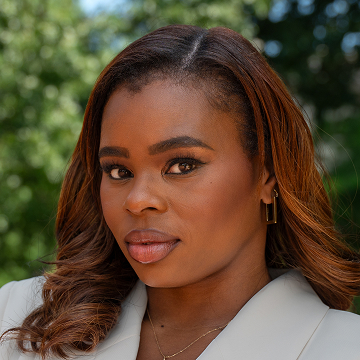CHICAGO — Outside the United Center on Monday, reporters from The Washington Post and The New York Times wandered around, lost, trying to find the places Democratic organizers had given them as workspace — like a practice gym for the Bulls that was converted into a filing center and is separated from the main arena by a parking lot.
Complaints about the media logistics of the Democratic National Convention — who gets what seats, how many, what’s the access like, how long does it take to get in, is there power and Wi-Fi — are not exactly swaying many votes. But as Kamala Harris faces new scrutiny about her reluctance to sit for traditional interviews or answer questions at a press conference, the media access choices organizers made with the DNC are carrying new weight, especially with the journalists on the ground.
One of the biggest objections has been about the dedicated seats the DNC provided for print reporters. While there are 12,000 credentialed reporters at this historic convention, hardly any of them have an assigned seat with a power outlet inside the bowl of the United Center, where the speeches are given and the delegates sit during prime-time hours.
There are 47 such seats for print and digital news outlets this year, a sharp drop-off from the more than 300 seats in 2016 and the 361 at the Republican National Convention last month, according to sources familiar with the planning.
For the outlets that couldn’t snag one of those dedicated “press stands” — seated workstations in the stadium with power sources and hardwired connections to the internet — there are about 100 other stadium seats with tabletops and power, as well as some open seats in the United Center. But there’s no guarantee any spot will be particularly accessible or comfortable.
“My knees are literally shoved into high voltage power equipment,” one person texted NOTUS from their spot in the media section.
When outlets learned about the cramped seating situation, many requested a disability accommodation for certain reporters. At least some of those requests were denied, with the DNC happily explaining they didn’t think the reporters needed an accommodation.
“After reviewing your request, we are pleased to inform you that there is no need to change your seat,” read one such email sent from a DNC media logistics manager to an outlet and obtained by NOTUS.
Meanwhile, the DNC has been bragging about the party’s efforts to make this the most accessible convention of all time, with organizers building a large wheelchair ramp to the convention floor and doing a victory lap in the press before the convention even started.
“We made a commitment this year for accessibility and inclusion to be an important part of the convention in all aspects, in everything we do,” Robin Jones, accessibility adviser to the Democratic National Convention Committee, told news site The 19th in a piece about how the DNC was prioritizing accessibility.
Another issue has simply been access.
While DNC officials told NOTUS the 1,100 floor passes handed out through the congressional press galleries was the same number as in 2016, many outlets are juggling a single floor pass among their team of reporters, swapping the credentials in quiet corners of the United Center as if they were confidential documents.The DNC also set aside some of the elusive floor space for the 200 credentialed content creators on what it’s calling “the first-ever Creator Platform to be built directly on the convention floor,” intended to operate like workspaces for TV stations, according to convention officials.
But even if the DNC is looking at credentialing influencers as a point of pride, many reporters saw it as a sore spot. In the seemingly zero-sum game of floor credentials, some reporters believed the floor passes that went to influencers could have gone to news outlets. (A DNC official told NOTUS that credentialing “content creators” hadn’t “impacted access or credential allocations for traditional media.”)
Still, some reporters complained they had been removed from a designated “creators lounge” that was one of the few places where a person could sit near power inside the United Center.
Logistics problems snagged the first day of the convention for everyone: delegates, reporters and influencers. Everyone trapped in buses by the protest movement or trapped in long lines to get through security had proof that things were not going smoothly.
Reporters who also attended the Republican convention in Milwaukee marveled at what they said was a completely different logistical situation.
Even with a security footprint that was hastily expanded in the wake of the attempted assassination of former President Donald Trump, there were media-only elevators and smooth sailing through checkpoints in Milwaukee. Almost everywhere reporters gathered on Monday, the comparative logistical struggles between the two conventions were part of the conversation.
By the end of that first day, the frustration was spilling into public view, with some reporters taking to X to share their concerns.
“Most surprising thing about [the convention] so far? The incompetence of their press logistics team,” Andrew Feinberg, a White House reporter for The Independent, posted on X. “Print reporters aren’t allowed on the floor. We are restricted from going anywhere near the TV booths to interview people. And the seats/workspace they set aside are so high up that they are unsafe.”
The organization that represents journalists for credentialing at the Capitol and at conventions — the Standing Committee of Correspondents — issued a statement on Monday saying it had attempted to negotiate for more space, particularly after Joe Biden dropped out of the race, but got nowhere with DNC organizers.
“The Standing Committee of Correspondents urged the DNC to allocate significantly more workspace for print journalists attending this year’s convention in Chicago than they decided to provide,” the Standing Committee of Correspondents told NOTUS in an emailed statement.
“While we appreciate the DNC’s willingness to listen to our requests, including after Vice President Kamala Harris became the nominee, we are concerned that the decision to reduce dedicated and accessible workspace by hundreds compared to prior conventions will hinder journalists’ ability to cover the historic nature of this convention.”
In his post, Feinberg blamed one person for the cuts in traditional media access: the Democratic National Convention’s director of media logistics, Peter Velz.
One source familiar with the convention’s media planning, granted anonymity to speak freely about the inner workings of the event, also put the changes on Velz.
“Peter Velz made these decisions,” this source said. “He received significant pushback throughout the process, and he didn’t want to listen to those concerns. If people are mad about the lack of positions, the availability of floor passes, the lack of access or the lack of accessibility, they should be mad at Peter Velz.”
Velz did not respond directly to those concerns. But a DNC spokesperson, Emily Soong, told NOTUS, “We’ve prioritized making sure members of the media have the resources they need to bring the story of our convention out to their communities from both inside and outside of the convention hall.”
Correction: This piece has been updated to more accurately describe the infrastructure of the work stations outside of the United Center.
Sign in
Log into your free account with your email. Don’t have one?
Check your email for a one-time code.
We sent a 4-digit code to . Enter the pin to confirm your account.
New code will be available in 1:00
Let’s try this again.
We encountered an error with the passcode sent to . Please reenter your email.


